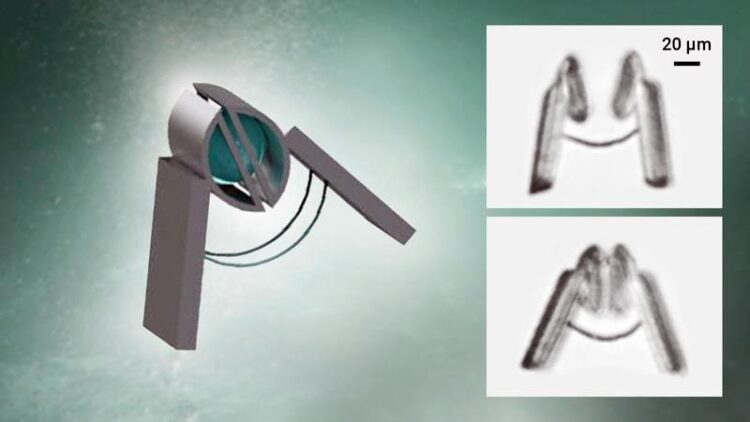Springs Aboard – Gently Feeling the Way to Grasp the Microcosmos

Picospring loaded microgripper. The microgripper opens and closes by changing the strength of a magnetic field.
Graphic: Jacob Müller / Photos: https://doi.org/10.1038/s41565-023-01567-0
Researchers from Chemnitz, Dresden und Shenzhen (China) describe in an article in the prestigious journal “Nature Nanotechnology“, how tiny magnetic springs can significantly advance medical applications.
The integration of mechanical memory in the form of springs has for hundreds of years proven to be a key enabling technology for mechanical devices (like clocks), achieving advanced functionality through complex autonomous movements. In our times, the integration of springs in silicon-based microtechnology has opened the world of planar mass-producible mechatronic devices from which we all benefit, via air-bag sensors for example. For a new generation of minimally and even non-invasive biomedical applications however, mobile devices which can safely interact mechanically with cells must be achieved at much smaller scales (10 microns) and with much softer forces (pico Newton scale i. e. lifting weights less than one millionth of a mg) and in customized three-dimensional shapes. Researchers at the Chemnitz University of Technology, the Shenzhen Institute of Advanced Technology of the Chinese Academy of Sciences and the Leibniz IFW Dresden, in a recent publication in Nature Nanotechnology, have now demonstrated that controllable springs can be integrated at arbitrary chosen locations within soft three-dimensional structures using confocal photolithographic manufacturing (with nanoscale precision) of a novel magnetically active material in the form of a photoresist impregnated with customizable densities of magnetic nanoparticles.
These “picosprings” have remarkably large and tuneable compliancy and can be controlled remotely through magnetic fields (even deep within the human body) allowing articulated motion in microrobots as well as micromanipulations well beyond the state of the art.

“Micropenguin” with picospring flippers swimming through fluid. Graphic: Jacob Müller / Photos: https://doi.org/10.1038/s41565-023-01567-0
Moreover, the extension of the picosprings can also be used visually to measure forces, for example propulsion or grasping forces, in interaction with other objects like cells. For example, these picosprings have been used to measure the locomotive propulsion force of sperm cells. The publication showcases these capabilities by demonstrating several microbots (including a micropenguin) containing picosprings at multiple locations that can do these tasks at cellular scales: propel themselves, grasp and release cells and measure the minute forces needed to do this safely. Figures 1 and 2 show two of these novel spring-loaded structures – a microgripper and a micropenguin extracted from the publication [https://doi.org/10.1038/s41565-023-01567-0].
Dr. Haifeng Yu, first author of the study and group leader at the Chinese Academy of Sciences in Shenzhen (China), says: “Programmable elasticity at the micrometer scale offers a feasible strategy for producing 3D devices and finely structured ‘micro-surgeons’ capable of performing complex medical tasks”.
Dr. Mariana Medina-Sanchez, group leader at the Leibniz IFW and BCUBE- TU Dresden, co-author and co-supervisor of this work, adds: “These picospring-based micromachines with programmable elasticity and magnetism, crafted through monolithic fabrication, open numerous possibilities for localized force sensing and actuation in low Reynolds number environments. This versatility underscores their significance across a spectrum of biomedical applications”.
Prof. Oliver Schmidt, who is last author of the paper and supervised this work, sees this as another important step in the transition towards life-ready soft and smart modular microrobotics. “Remotely controlled microdevices using magnetic fields form a particularly promising technology for non-invasive medical applications – and now this extends to mechanical mechanisms inside these remote microdevices”, says Schmidt.
“Being able to incorporate designer springs will also add a new tool to the growing capability at TU Chemnitz towards microelectronic morphogenesis and artificial life,” adds Prof. John McCaskill, co-author of the study, member of the Research Center MAIN, and Founding Director of the European Centre for Living Technology. The topic “Microelectronic Morphogenesis” was covered in a recent press release.
This project has received funding from the European Research Council (ERC) under the European Union’s Horizon 2020 research and innovation programme (grant agreements No 835268, and No. 853609).
Wissenschaftliche Ansprechpartner:
Prof. Dr. Oliver G. Schmidt, Scientific Director of the Research Center MAIN and Chair of the Professorship of Material Systems for Nanoelectronics at the TU Chemnitz, E-Mail oliver.schmidt@main.tu-chemnitz.de, Dr. Mariana Medina-Sánchez, Leibniz IFW and BCUBE TU Dresden. E-mail: m.medina.sanchez@ifw-dresden.de, Dr. Haifeng Xu, Shenzhen Institute of Advanced Technology (SIAT) E-Mail hf.xu@siat.ac.cn, as well as Prof. John S. McCaskill, Research Center MAIN and Fellow of the European Centre for Living Technology, Venice, E-Mail john.mccaskill@main.tu-chemnitz.de
Originalpublikation:
Publication: 3D nanofabricated soft microrobots with super-compliant picoforce springs as onboard sensors and actuators, Haifeng Xu, Song Wu, Yuan Liu, Xiaopu Wang, Artem K. Efremov, Lei Wang, John S. McCaskill, Mariana Medina-Sánchez, Oliver G. Schmidt. Nature Nanotechnology (2024).
Media Contact
All latest news from the category: Materials Sciences
Materials management deals with the research, development, manufacturing and processing of raw and industrial materials. Key aspects here are biological and medical issues, which play an increasingly important role in this field.
innovations-report offers in-depth articles related to the development and application of materials and the structure and properties of new materials.
Newest articles

Innovative 3D printed scaffolds offer new hope for bone healing
Researchers at the Institute for Bioengineering of Catalonia have developed novel 3D printed PLA-CaP scaffolds that promote blood vessel formation, ensuring better healing and regeneration of bone tissue. Bone is…

The surprising role of gut infection in Alzheimer’s disease
ASU- and Banner Alzheimer’s Institute-led study implicates link between a common virus and the disease, which travels from the gut to the brain and may be a target for antiviral…

Molecular gardening: New enzymes discovered for protein modification pruning
How deubiquitinases USP53 and USP54 cleave long polyubiquitin chains and how the former is linked to liver disease in children. Deubiquitinases (DUBs) are enzymes used by cells to trim protein…



